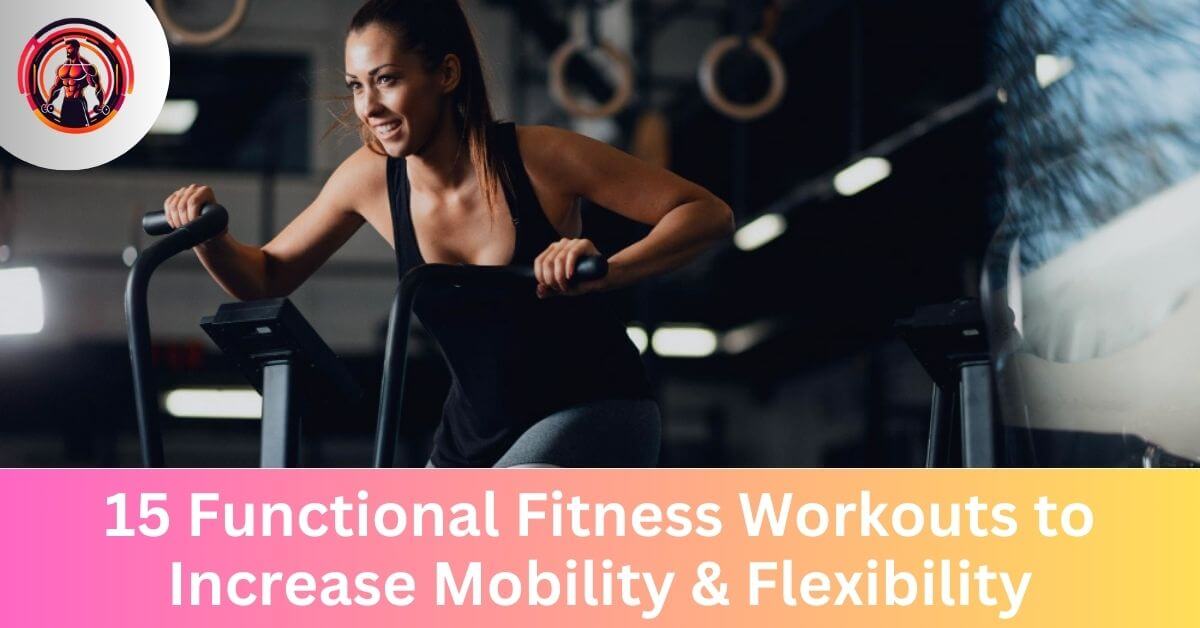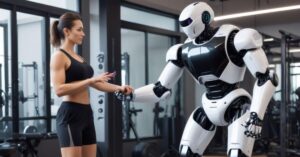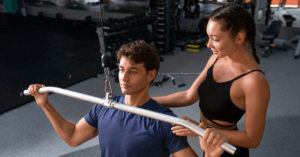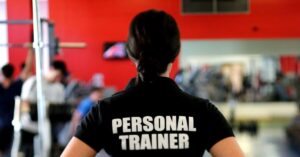Take a trip towards improved flexibility and more range of motion with our all-inclusive functional fitness exercise program.
It is crucial now more than ever to give priority to exercises that increase functional strength and flexibility because we live in a fast-paced society where sedentary lifestyles and repetitive activities often impair mobility.
Let’s go through the Top 15 Best Functional Fitness Workouts to Increase Mobility & Flexibility. R
They are meant to focus on specific body parts, releasing tense muscles, increasing joint mobility, and augmenting general flexibility.
Every workout, from full-body functional motions to dynamic stretching routines, is designed to make you move more effectively and efficiently in everyday life.
Here’s the list of Top 15 Best Functional Fitness Workouts to Increase Mobility & Flexibility
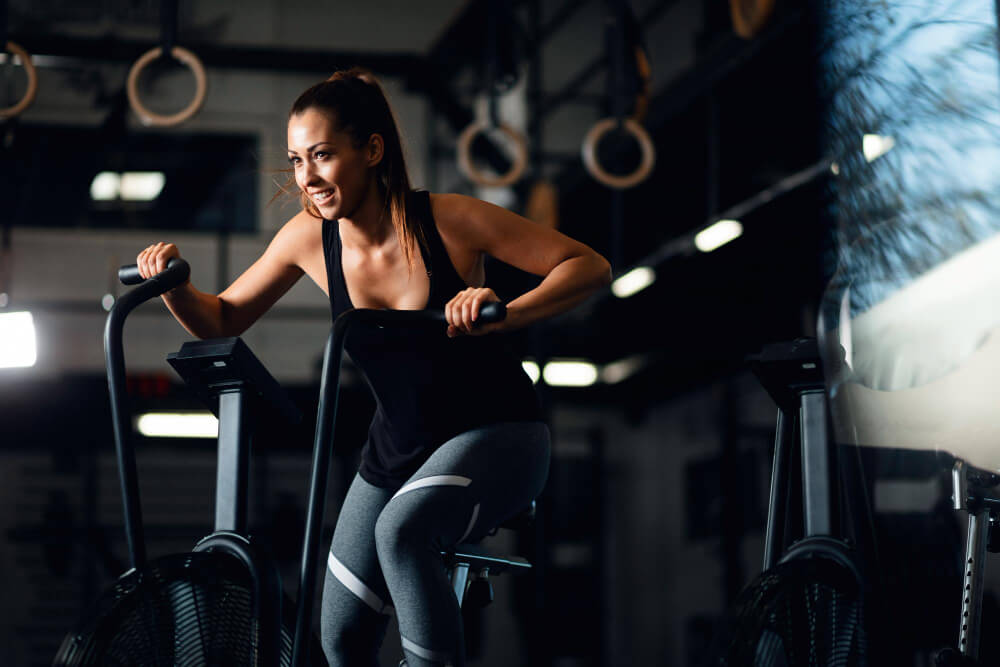
1. Dynamic Warm-Up Routine (5 minutes)
Start your workout with a dynamic warm-up routine to prepare your body for movement while simultaneously improving mobility and flexibility.
Include exercises such as arm circles, leg swings, hip rotations, and shoulder rolls. Dynamic stretching helps increase blood flow to the muscles, lubricates the joints, and improves range of motion.
2. Squat to Stand (10 reps)
The squat-to-stand exercise targets multiple muscle groups, including the hamstrings, glutes, and lower back, while also enhancing hip flexibility.
Begin in a standing position, squat down as low as you can comfortably go, and then reach your arms overhead while keeping your spine straight. Return to the starting position and repeat for 10 reps.
READ MORE: 10 Best No Equipment Bicep Workouts to Boost Arm Size at Home
3. Walking Lunges (10 reps each leg)
Walking lunges not only strengthen the lower body but also improve hip mobility and flexibility.
Take a large step forward with one leg, bending both knees to lower your body toward the ground. Keep your torso upright and engage your core. Push off the front foot to return to the starting position and repeat on the other side.
4. Cat-Cow Stretch (10 reps)
The cat-cow stretch is a yoga-inspired movement that targets the spine, improving its flexibility and mobility. Begin on your hands and knees with a neutral spine. Inhale as you arch your back, dropping your belly towards the floor (cow position).
Exhale as you round your spine, tucking your chin to your chest (cat position). Repeat for 10 reps, flowing smoothly between the two positions.
5. Hip Flexor Stretch (Hold for 30 seconds on each side)
Tight hip flexors can restrict mobility and contribute to lower back pain.
To stretch the hip flexors, kneel on one knee with the other foot planted flat on the ground in front of you. Lean forward slightly, feeling the stretch in the front of the hip of the kneeling leg. Hold for 30 seconds and then switch sides.
6. Shoulder Dislocations with Resistance Band (10 reps)
Shoulder dislocations with a resistance band help improve shoulder mobility and flexibility. Hold a resistance band with both hands shoulder-width apart.
Keeping your arms straight, lift the band overhead and then behind your back as far as you can go. Reverse the movement to bring the band back to the starting position. Repeat for 10 reps.
7. Downward Dog to Cobra Flow (10 reps)
This dynamic movement sequence combines two yoga poses, downward dog, and cobra, to stretch and mobilize the entire body.
Start in a plank position, then lift your hips up and back into downward dog, pressing your heels towards the floor while reaching your chest towards your thighs.
Shift forward into a cobra position by lowering your hips towards the ground and arching your back while lifting your chest. Flow between downward dog and cobra for 10 reps.
8. Thoracic Rotation Stretch (10 reps on each side)
The thoracic rotation stretch improves mobility in the mid-back and shoulders. Begin in a seated position with your legs extended in front of you.
Cross one leg over the other and place the opposite elbow on the outside of the crossed knee. Rotate your torso towards the crossed leg, feeling a stretch in the mid-back.
Hold for a moment, then return to the starting position and repeat on the other side.
9. Ankle Circles (10 reps in each direction)
Ankle mobility is often overlooked but essential for proper movement mechanics.
Sit on the ground with one leg extended and the other knee bent. Rotate your ankle in a circular motion, first clockwise and then counterclockwise. Perform 10 reps in each direction, then switch legs.
10. Seated Forward Fold (Hold for 30 seconds)
The seated forward fold is an excellent stretch for the hamstrings, lower back, and spine. Sit on the ground with your legs extended in front of you.
Hinge at the hips and reach towards your toes, keeping your back straight. Hold the stretch for 30 seconds, breathing deeply to deepen the stretch.
11. Standing Quad Stretch (Hold for 30 seconds each leg)
Tight quadriceps can limit hip mobility and contribute to knee pain.
Stand tall and grab one foot behind you, bringing your heel towards your glutes. Keep your knees together and your pelvis tucked under to intensify the stretch. Hold for 30 seconds, then switch legs.
12. Side Lunge Stretch (10 reps on each side)
Side lunges target the inner and outer thighs while also improving hip mobility.
Start in a standing position with your feet hip-width apart. Take a wide step to the side with one foot, bending the knee while keeping the other leg straight.
Shift your weight towards the bent knee, feeling a stretch in the inner thigh. Return to the starting position and repeat on the other side for 10 reps on each side.
13. Standing Calf Stretch (Hold for 30 seconds on each leg)
Tight calves can affect ankle mobility and contribute to foot and knee pain.
Stand facing a wall with your hands resting on the wall for support.
Step one foot back and press the heel into the ground while keeping the knee straight. Lean forward slightly to deepen the stretch in the calf. Hold for 30 seconds, then switch legs.
14. Wrist Flexor Stretch (Hold for 30 seconds on each side)
Improving wrist mobility is essential for various functional movements, especially those involving upper body strength. Extend one arm in front of you with the palm facing up.
Use your other hand to gently pull back on the fingers, feeling a stretch in the wrist and forearm. Hold for 30 seconds, then switch sides.
15. Full-Body Foam Rolling (5-10 minutes)
Finish your workout with a full-body foam rolling session to release tension in the muscles and improve overall mobility.
Target areas such as the calves, hamstrings, quadriceps, glutes, back, and shoulders. Spend 1-2 minutes on each muscle group, focusing on areas of tightness and discomfort.
Summary
Here is the summary of the blog titled “Top 15 Best Functional Fitness Workouts to Increase Mobility & Flexibility“
- Dynamic Warm-Up Routine (5 minutes)
- Squat to Stand (10 reps)
- Walking Lunges (10 reps each leg)
- Cat-Cow Stretch (10 reps)
- Hip Flexor Stretch (Hold for 30 seconds on each side)
- Shoulder Dislocations with Resistance Band (10 reps)
- Downward Dog to Cobra Flow (10 reps)
- Thoracic Rotation Stretch (10 reps on each side)
- Ankle Circles (10 reps in each direction)
- Seated Forward Fold (Hold for 30 seconds)
- Standing Quad Stretch (Hold for 30 seconds on each leg)
- Side Lunge Stretch (10 reps on each side)
- Standing Calf Stretch (Hold for 30 seconds on each leg)
- Wrist Flexor Stretch (Hold for 30 seconds on each side)
- Full-Body Foam Rolling (5-10 minutes)
Final Words
These 15 functional fitness exercises can greatly increase your range of motion and flexibility, giving you greater freedom to move around and carry out daily duties with ease.
Always pay attention to your body’s signals and adjust exercises to your current fitness level, injuries, and limits. To fully benefit from increased flexibility and mobility, make it a goal to execute these exercises on a regular basis.
Consistency is crucial. You can experience more mobility in your daily life and improve your general health and well-being with commitment and persistence.
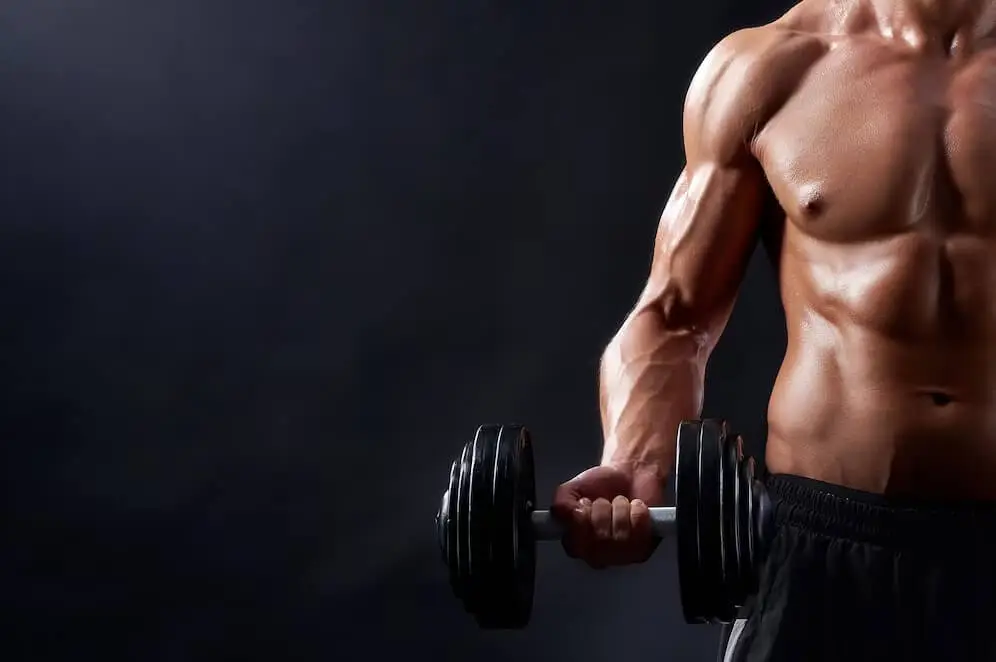
Looking for your Own Personal Trainer?
FAQs
Q. What is functional fitness, and why is it important?
Ans. Functional fitness focuses on exercises that mimic everyday movements, enhancing strength, flexibility, and mobility for activities of daily living. It’s essential because it helps improve overall physical functionality, reduces the risk of injury, and enhances quality of life.
Q. How often should I perform these functional fitness workouts?
Ans. It’s recommended to perform functional fitness workouts at least 2-3 times per week to see significant improvements in mobility and flexibility. However, listen to your body and adjust the frequency based on your individual needs and recovery time.
Q. Can I do these exercises if I’m a beginner or have limited mobility?
Ans. Yes, many of these exercises can be modified to suit beginners or those with limited mobility. Start with easier variations and gradually progress as your strength and flexibility improve. Consult with a fitness professional or physical therapist for personalized modifications if needed.
Q. Are there modifications available for those with injuries or physical limitations?
Ans. Absolutely. It’s crucial to prioritize safety and avoid exacerbating injuries. Modifications such as reducing the range of motion, using props or support, or choosing alternative exercises can help accommodate injuries or physical limitations. Always consult with a healthcare professional for tailored advice.
Q. How long will it take to notice improvements in mobility and flexibility?
Ans. The time it takes to notice improvements can vary depending on factors such as current fitness level, consistency, and individual differences. However, with regular practice, many people experience noticeable improvements in mobility and flexibility within a few weeks to a few months.
Q. Can I incorporate these exercises into my existing workout routine?
Ans. Absolutely. These exercises can complement various workout routines, whether you’re focusing on strength training, cardio, or flexibility. Consider integrating them as part of your warm-up, cooldown, or dedicated mobility sessions to reap the benefits.
Q. Is it necessary to warm up before starting these functional fitness workouts?
Ans. Yes, warming up is crucial to prepare your body for physical activity, increase blood flow to the muscles, and reduce the risk of injury. The provided dynamic warm-up routine is specifically designed to prime your body for movement and improve flexibility and mobility before engaging in the main exercises.

